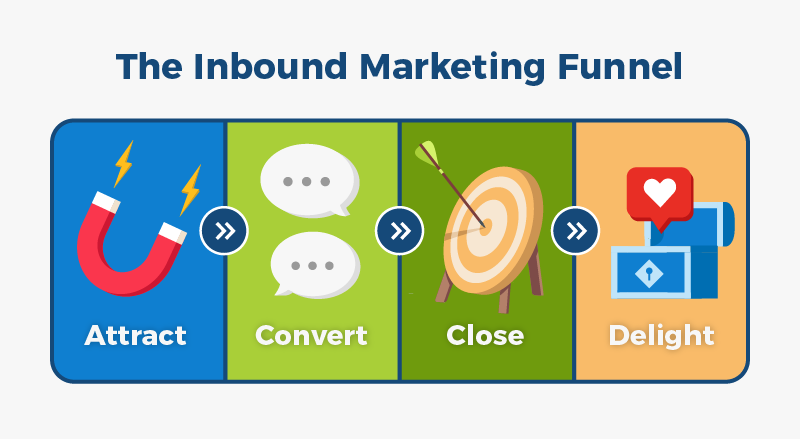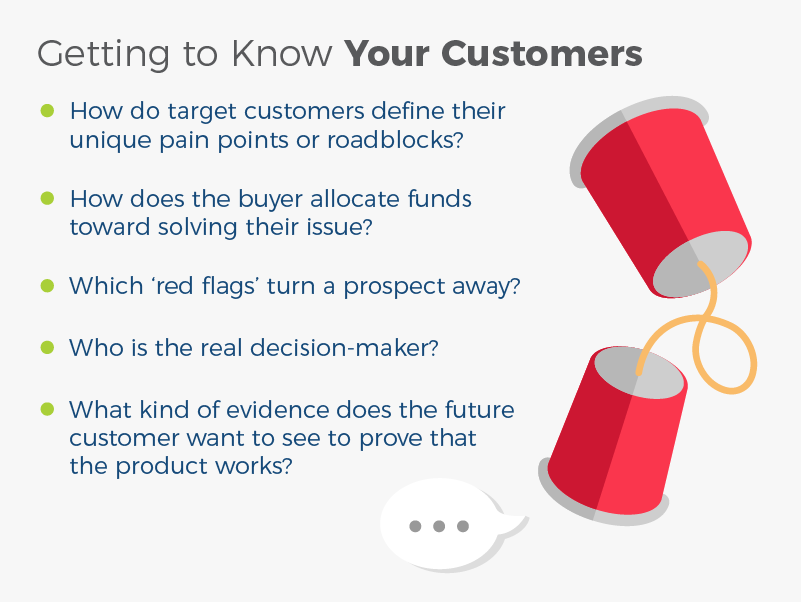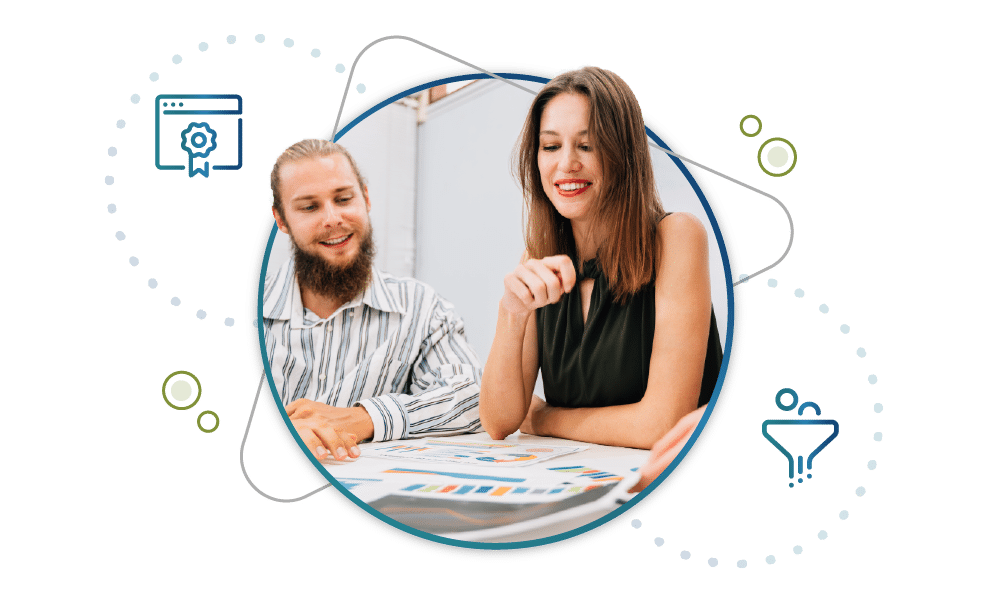As a business owner, you have to develop a keen sense of industry trends and apply these new strategies to your business. Once you start to explore the process of attracting, engaging, and delighting your ideal customers, you’ll quickly spot the need for an effective inbound marketing sales funnel.
If you’ve started to implement inbound marketing campaigns, your target audience is hopefully discovering your content. As your lead conversion rates increase, you need a plan for how to handle future interactions.
In this resource, we’ll take the guesswork out of defining the inbound marketing funnel, how it differs from traditional models, and where the next evolution brings us. You’ll also get an overview of the different levels and an introduction to important concepts like buyer journeys and personas.
In this blog, we’ll look at the following:
- Understanding the Inbound Marketing Funnel
- The Classic Sales Funnel
- Top of Funnel
- Middle of Funnel
- Bottom of Funnel
- Stages of the Buyer’s Journey
- Getting to Know Your Customers
- What is a Buyer Persona?
Understanding the Inbound Marketing Funnel
Truthfully, the inbound marketing funnel stages are not difficult to understand. The funnel itself may even seem natural and intuitive if you already have experience in marketing.
According to Bristol Strategy, inbound marketing involves “attracting interested prospects through relevant and helpful content that provides educational value that is personalized to them and where they are in their journey.”
Instead of broadcasting mass messages to randomly selected groups, inbound marketing harnesses the power of online outlets to deliver high-quality content at the right time.

It’s easy to see why this strategy is more effective than throwing out a variety of messages and hoping they stick. The inbound marketing funnel is typically composed of four main stages. These stages are:
Attract
Attraction is the process of gaining the attention of unknown leads or prospects. This is accomplished by offering valuable content that meets them wherever and whenever they’re searching.
Convert
Conversion means offering a call to action. What are the next steps a visitor can take once they begin to engage?
Close
Closing happens when leads become customers. The closing actions occur after the lead has received messaging, including nurture tracks or follow-up emails, that solidify a decision to buy.
Delight
The stage of delight showcases how regular customers become raving fans. At this point, the deal is closed, and the opportunity has been won. Loyal customers are a powerful asset and can deliver helpful feedback.
The Classic Sales Funnel
In the classic sales funnel model, audiences receive word about a product or service whether or not they are actually interested. Those who are interested at a basic level become cold prospects through a series of automation. In order to move to the next stage with a salesperson, prospects go through qualification and may receive a follow-up call or live demonstration.
In the traditional model, customers usually have an opportunity to ask questions, see the product or service, and negotiate. This seller-focused model results in a final outcome of Closed Won/Lost, meaning that a salesperson finalized or dropped a deal.
Top of Funnel
In inbound marketing, the very top refers to prospects who are visiting or learning. Up to 85% of website visitors are likely to fall in the top funnel category. Developing a top of funnel strategy requires an understanding of what people are researching and how those answers point to your company.
Top of Funnel Marketing Tactics
Several tactics can help the visitors at the top of the funnel feel valued through your inbound marketing efforts. These tactics should include:
- Offering visible, high-quality content. Think eBooks, infographics, or easy-to-interpret downloads that solve a problem or answer a common question.
- Resisting the urge to be salesy. Offering a sales opportunity comes later. For now, build trust without the added pressure of making a purchase.
- Fine-tuning your blog efforts. A blog is often a visitor’s first impression. Occasionally, a blog article is how they found your site in the first place. Make sure the blog’s voice, style, and design are in line with your brand guidelines.
Middle of Funnel
Individuals in the middle of the inbound marketing funnel are sometimes referred to as shoppers. They’ve got a problem or pain point, and they have enough experience to be able to ask detailed questions.
Middle of Funnel Marketing Tactics
Here are a few middle of funnel strategies to serve this group of people who want active answers to their questions:
- Embrace the diversity. The waters get a bit cloudy in the middle of the journey, with some prospects more ready to convert than others. Be aware of this and offer a few unique content options accordingly.
- Educate with backup. Visitors here are more likely to want proof of expertise. Case studies and educational whitepapers can serve as strong assets during this stage.
- Nurture, nurture, nurture. Research indicates that a well-planned nurture sequence can generate up to 50% more sales. This process requires careful thought, planning, and consideration.
Bottom of Funnel
Being at the very bottom of the inbound funnel means that a lead is very familiar with your product or service and is ready to engage further. Although you should definitely capitalize on leads at the bottom, the truth is that every lead can hit this stage. To be a successful business owner, you must keep this larger perspective of getting leads to this stage in mind.
Bottom of Funnel Marketing Tactics
While you’ve done a considerable amount to help a lead arrive at the bottom of the funnel, now is not the time to give up! Try a few of these strategies to see more return:
- A free trial or demo: If you have something you can give an opportunity to test out, let the prospect take it for a spin. Set a timeframe and check back in once the trial is complete.
- Consultations: Leads at this level may want to meet one-on-one with a team member. Have experienced staff ready to tackle difficult questions with excitement and professionalism.
- Calls to action: Sometimes, the most simple advice is the most effective. Your prospect may just need that final call to action to help them pull the lever. If you never ask, you may never know if the answer is yes or no!
From Funnel to Flywheel
Growing a business is a constantly evolving process, and as such, while the funnel approach is still relevant, many innovative companies are moving to the new Flywheel model.
First coined by HubSpot, the flywheel differs from the traditional image of a funnel in that it is not a top-down approach. Conversely, it’s a continuous cycle that builds momentum time and again. The flywheel imagery places customers at the very center of the process while the other stages circle around it. These include:
- Marketing (Attracting the customer)
- Sales (Engaging the customer)
- Service (Delighting the customer)
Proponents of the flywheel understand that the customer’s journey should not end when the transaction is complete. There is a massive opportunity to keep your customers engaged with your business. Turn them into repeat customers who tell their network all about your business. This makes your flywheel spin faster and propels your company’s growth.
Stages of the Buyer’s Journey
To fully set up your marketing flywheel, it’s crucial to understand how a buyer makes their decision. When you boil it down, the buyer’s journey could almost be defined as “doing a ton of Internet research before making a purchase.” In reality, there are three widely accepted stages of this “research” process.
- Awareness: The buyer knows what problems they need to solve. They begin to absorb published content and information that helps validate solutions to these problems.
- Consideration: The buyer is actively investigating and weighing options. Strong, evidence-based content helps educate and reach leads at the deepest level of their search.
- Decision: The buyer has selected a few top contenders that can help solve the big issue. They might survey several competing companies to weigh strengths, weaknesses, and costs.
At each point in the buyer’s journey, there’s an opportunity to attract and engage your target customer. By producing excellent inbound content, marketing teams help this journey happen seamlessly while answering important questions that later drive sales results.
Getting to Know Your Customers
If there’s one pattern emerging, it’s that a rich knowledge of who your customers are is vital. In fact, the inbound marketing flywheel is not very transformational (to businesses or prospects) if there isn’t a clear picture of who the intended customer really is.

At a basic level, getting to know customers happens best by asking questions. Whether you poll a target audience or think critically about these questions internally, it’s important to devote time to this step. You may ask questions like:
- How do target customers define their unique pain points or roadblocks?
- How does the buyer allocate funds toward solving their issue?
- Which ‘red flags’ turn a prospect away?
- Who is the real decision-maker?
- What kind of evidence does the future customer want to see to prove that the product works?
This is just a basic start to the list of questions your team can create. Regardless of how you get to know your customers, doing so is the best way to ensure success with your inbound marketing strategy.
What is a Buyer Persona?
There’s a good deal of vocabulary in the world of inbound marketing, but “buyer persona” is one term you don’t want to miss. A buyer persona is a semi-fictional representation of the client or customer who most aligns with your target audience.
Ideally, you should define a buyer persona through market research. You can also survey your existing customer base to confirm that your attraction efforts are hitting home. Some of the best wins are interviewing existing customers who knew nothing about your business and are now referring business to you consistently.
Defining your buyer personas can influence how you handle:
- Inbound marketing strategies
- Content creation and brainstorming
- Sales calls and follow-ups
- Churn rate and retention
Are there different types of buyer personas?
While the primary buyer persona helps you define key marketing actions, sometimes you can identify a negative buyer persona. This paints the picture of those individuals you aren’t trying to attract with your marketing efforts. A negative persona can also help you identify site visitors who may be interested in what you produce but have no intention to buy.
Accelerate Your Inbound Results
Are you ready to finetune your inbound marketing strategy and gain impressive results at every stage of the buyer’s journey? Striventa’s team of experts can help.
Take a look at our most notable case studies to learn how the team at Striventa can help you solve your biggest inbound marketing headaches and generate more lead conversion.

